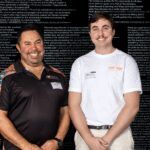Kathleen Toomath.
Author | Carmelle Wilkinson
Aboriginal and Torres Strait Islander people are warned that photographs/videos on this page contain images of deceased persons, which may cause sadness or distress.
Whether she was painting large murals on the back patio with her Mum or busking in Northbridge on a Friday night with hand drums, Kathleen Toomath (John Curtin Gallery Manager) always found ways to feed her creativity.
The hardworking single Mum completed a diploma in contemporary music from AB Music whilst juggling Film and TV studies at Curtin University and raising five young children.
She said her passion for the arts was ignited from a young age, when she would accompany her artist Mum Alma Toomath to art classes at Claremont Technical College.
Too young to sit in on the life drawing lessons, she would wander down to the library and amuse herself by looking through large glossy art books.
“I was captivated. I couldn’t read at the time, but I would sit there just admiring the beautiful pictures,’’ she said.
“That’s where my love for art began, but I guess it’s always been a part of me.”
Her Mum Alma went on to become the first Aboriginal women in WA to attain a fine arts degree.
Years later, when an opportunity arose to safeguard precious artworks by children of the Stolen Generations at John Curtin Gallery, including her extraordinary Mum Alma Toomath, Kathleen didn’t hesitate.
Produced in the 1940s by children from the Carrolup Native Settlement in Katanning, the artworks were rediscovered in storage at Colgate University in New York after nearly 60 years lost overseas.
Providing a rare glimpse into the lives of the children of the Stolen Generations, who were forcibly removed from their families, the treasured pieces are a colourful yet sombre reminder of Australia’s poignant past.
Entrusted to Curtin University and now in the care of the John Curtin Gallery, the artworks depict the strength and resilience of Aboriginal spirituality and culture and give us hope for a better and brighter future.
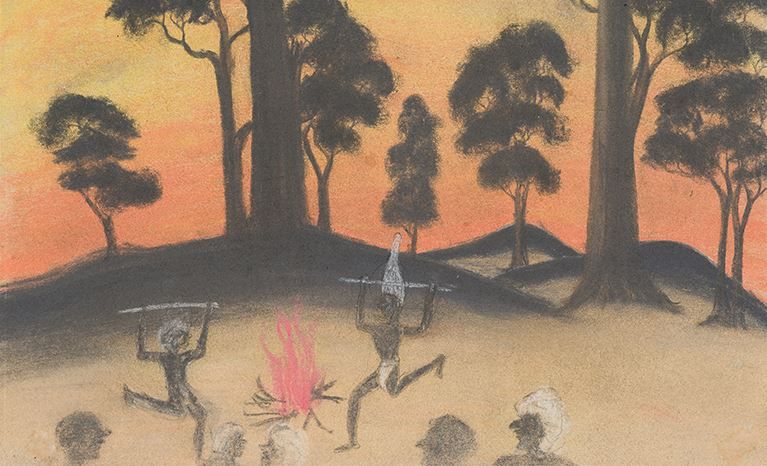
Once known child artist, On with the Dance c1949, pastel and graphite on paper, 281mm x 378mm.
Taking inspiration from their natural environment, the epic collection offers a window to the outside world, from simple charcoal sketches to complex pastel paintings – echoing rich sunsets, dramatic landscapes and silhouettes of Aboriginal men and animals.
The renowned child artists of Carrolup produced a distinctive painting style with many continuing their practice into adulthood.
An artist in her own right, Kathleen is an advocate for healing and is deeply involved in the development and management of Curtin’s Carrolup Centre for Truth-telling.
“Each of these works tell a unique story from every child’s experience and I embrace my new role in nurturing and sharing these remarkable works for generations to come,” Kathleen said.
Last month a selection of the treasured collection made their way to the UK, where they will feature in two exhibitions at The Portico Library in Manchester and the University of Glasgow Memorial Chapel in Glasgow.
Taken to the UK 70 years ago by philanthropist Florence Rutter in the 1950s following her visit to WA, many of the artworks never made the long-journey home.
The exhibitions have now sparked a global search for hundreds of missing Carrolup artworks, thought to be lost or kept in private collections.
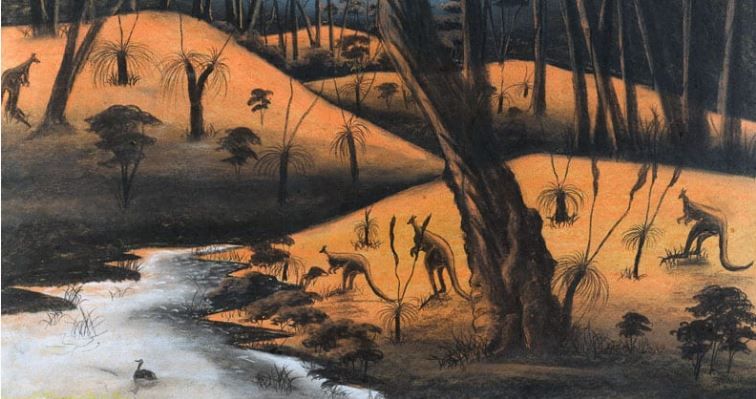
Parnell Dempster, Down to Drink, 1949, pastel, 58 x 76cm.
Committed to sharing the experiences and impact of colonisation, Kathleen seeks to contribute to a brighter future, where Aboriginal and non-Aboriginal people have mutual respect and walk harmoniously side by side.
As one of the last recognised Carrolup artists, Alma sadly passed away a year ago, but through Kathleen and her wonderful work at the gallery, her Mum’s legacy lives on.
Thank you for taking the time to share your story with us Kathleen. I understand the exhibitions in Manchester and Glasgow in the UK hope to uncover lost Carrolup artworks. What would it mean for you to have some of these artworks returned home to Nyungar Country?
Personally, any repatriation of First Nation’s arts or culturally significant artefacts back to the peoples of origin is an important step in respect and could be conceived as a real act of reconciliation.
For Community, the return can open up many other aspects of cultural activity and resurgence in practice. In terms of specific Carrolup artworks coming back to country, even one that’s signed or identified to an artist/creator would mean so very much to our peoples.
Imagine a work of a child artist who was your grandmother and yet you never got to meet her because she passed before you were born and there are no known photographs of her and all you know is her name and the work of art coming back is the only thing in the world that represents her, was made by her.
That makes that artwork a highly precious and rare representation of her. If a work came back to us of any of the once known artists that could connect us to their family, that would be enough for me.
For audiences who see these artworks, what would you like them to take away more than 50 years after they’ve been painted?
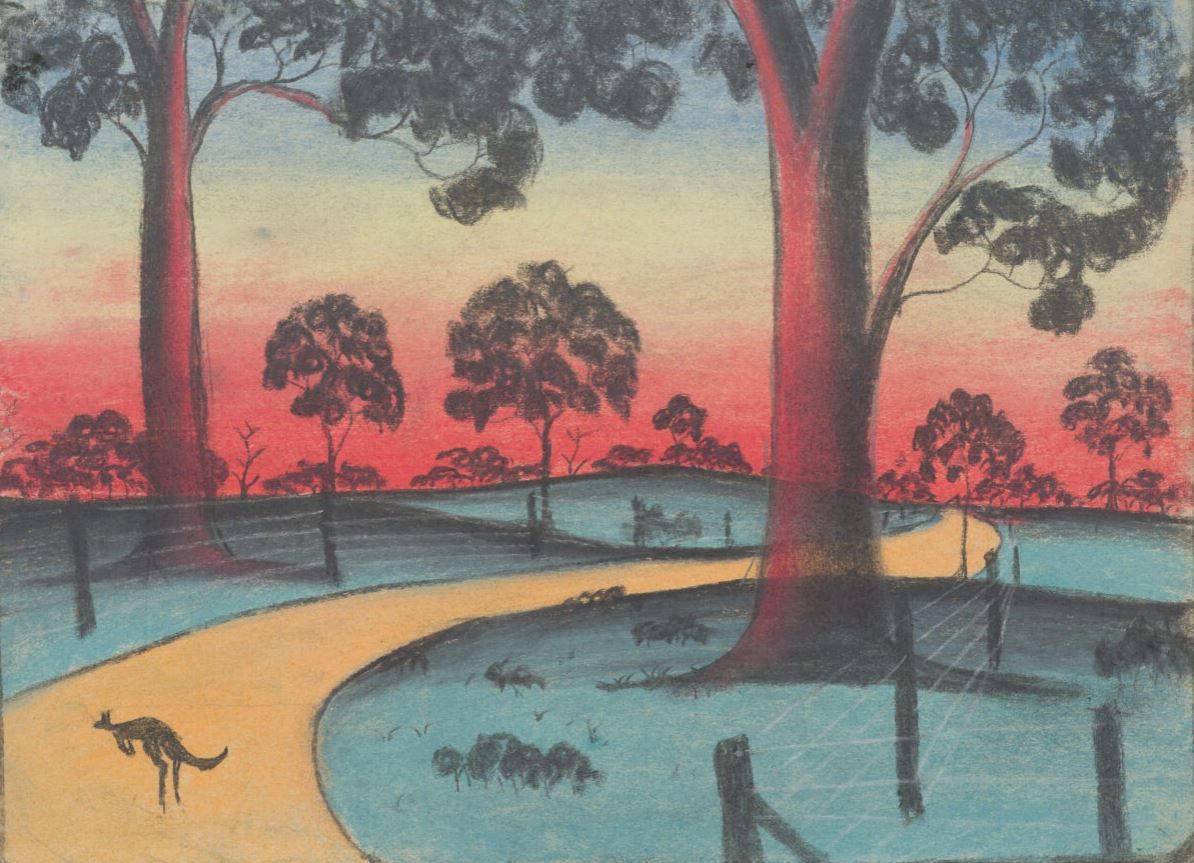
Once known child artist, The Golden Road c1949, pastel on paper, 280mm x 385mm.
That it is possible to make tomorrow better through the power of art.
To understand that the Carrolup Child Artist movement was integral in developing a style of art developed by the children themselves in their interpretation of their environment.
This style continues in the descendant artists of the region. I would hope people see and understand that the making of art by the Carrolup children was an expression of connection to their country, our country/boodja being our mother, for many, the only mother they ever knew.
What an incredible honour then to be safeguarding these incredible artworks. How significant is it to protect and preserve these national treasures for generations to come?
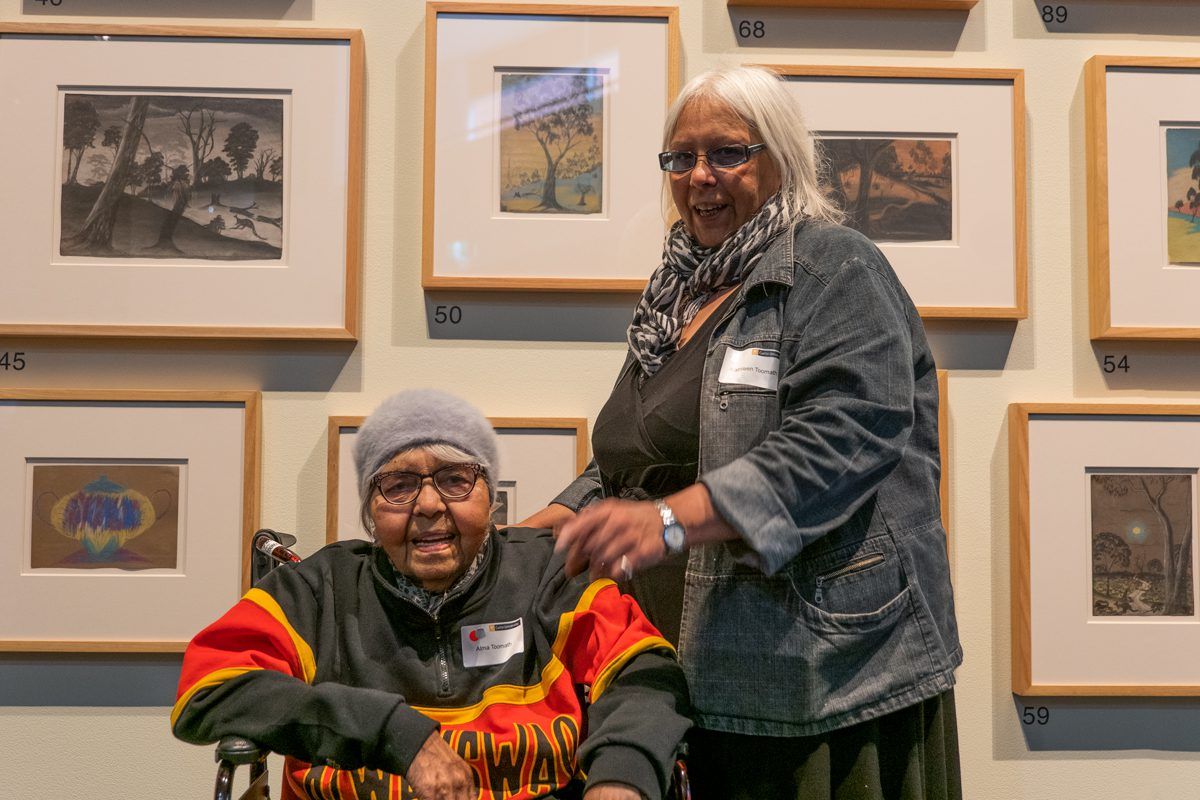
Kathleen with her mum Alma.
I am very honoured to be carrying on my Mum’s legacy. The artworks are one of the very few surviving documentary records produced by members of the Stolen Generations.
I think for many of the artists who participated in that child art movement like my Mum – art became their life. It was how Mum achieved her self-esteem and through art, she was able to create economical change for herself and our family.
Using blackboard chalk and later pastels, these children learnt to express themselves, taking inspiration from the natural environment and their Noongar culture.
It’s hard to imagine how a child can thrive and reach their full potential if they don’t have that basic human comfort and love from their parents. So these Carrolup children, I have to give it to them, they created such amazing art despite their limitations and traumatic experiences.
Ensuring these drawings and paintings remain accessible to Aboriginal and non-Aboriginal people throughout WA and beyond has now become my greatest fulfilment.
As a single Mum of five, carving a career in the arts couldn’t have been easy. How did you do it?
It was certainly not easy yes, but I made it work.
I’d do my grocery shopping on Thursday mornings between 8am-10am because that was the only spare time I had between studying film and tv and music.
I wanted to set a good example for my kids and fulfill a purpose I knew I had in me.
I hear you were quite the stunt woman growing up. Do you still ride motorcycles?
Haha no I’m not allowed to these days, as I’ve hurt my back. But growing up when I wasn’t painting or working on my art, I was always on the back of a motorcycle.
When I was 17, I was on the back of my brother’s friends’ motorcycle when we had a terrible accident one night.
We had just approached a large T-junction when the brakes failed, and we went across two median strips and crashed into a property’s brick wall.
I was thrown from the bike and went through an asbestos fence and landed in a rose bush.
Thankfully we walked away from the crash with only a few scratches and bruises but only recently I’ve experienced an onset of back pain, which Dr’s are attributing to that crash all those years ago.
You mentioned you were exposed to art from a young age. Did your Mum influence your career in art?
Yes, thanks to Mum I engaged in art from a very young. I grew up surrounded by art, and I knew from quite little that that’s what I wanted to do. But I actually never felt comfortable calling myself an artist until my first commission.
Growing up, I would help Mum paint large 6m x 6m murals on our back patio which we’d sell to the education department and tourism industry.
We’d also create paperbark painting, ceramics and jewellery.
It was during these times of creativity in our backyard that Mum would talk about cultural things and share about her time at Carrolup, much like if we were sitting outside in the dirt in a cultural sense.
I think the action of doing the work brought out the yarns and I enjoyed it, I wanted to know everything.
After high school I moved to Claremont to live with my grandparents and started a fine arts degree at Claremont Technical College like Mum. However, I was only 16 at the time and still finding my place in the world and I found I couldn’t commit to the workload.
While I didn’t end up completing my diploma, I did pick up skills which are still with me today,
I always say I may not have the pieces of paper, but I left the school with life experience.
You mentioned art gave your Mum greater self-awareness and confidence. Do you believe art has the power to improve mental health and alleviate trauma and stress? How does art help in the healing space?
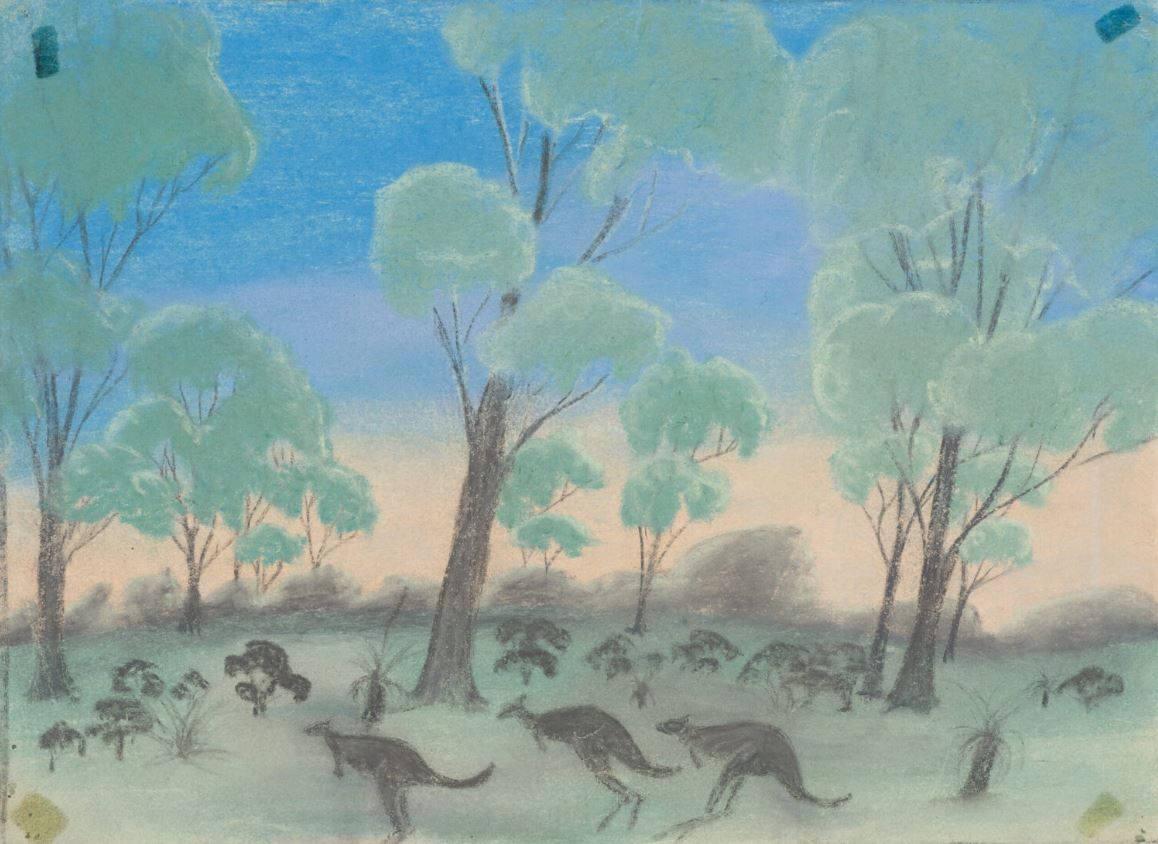
Carrolup artwork.
Art gave those Carrolup children like Mum resilience, self-esteem and purpose.
Each of the amazing works tell a unique story from every child’s experience and offers a beautiful insight into their life.
I think any form of creative human expression can help you evolve and deal with issues you’re confronting.
In 2018 I lost my second eldest daughter quite tragically, and I don’t think I’ve ever regained my strength or who I was before that shocking moment. When something that profound happens in your life, you lose your way a bit.
Personally, I find art a good distraction from whatever you are going through. It can help us heal.
I find art very calming and natural and feel it’s important that all people regardless of whether they think they have capacity or not, to engage in some form of art. It’s how the brain fires up.
I’m currently working on a large piece and have no reference point other than what is in my head. But for me to go home at the end of a long day and stick my hands in cold clay – it shifts my mind into a peaceful state and I’m able to disengage with the pressures of life and work.
For me, the joy comes in the creating and making, and not the final outcome.
Whenever I look at these Carrolup drawings I am astonished at how enthusiastic the children were and the level of sophistication in their landscape drawings.
Last month, State Aboriginal Affairs Minister Tony Buti and WA Governor Kim Beasley announced a $1.76m Lotterywest fund for Curtin’s Carrolup Centre for Truth Telling. How will this injection of funds assist your vision for its future?
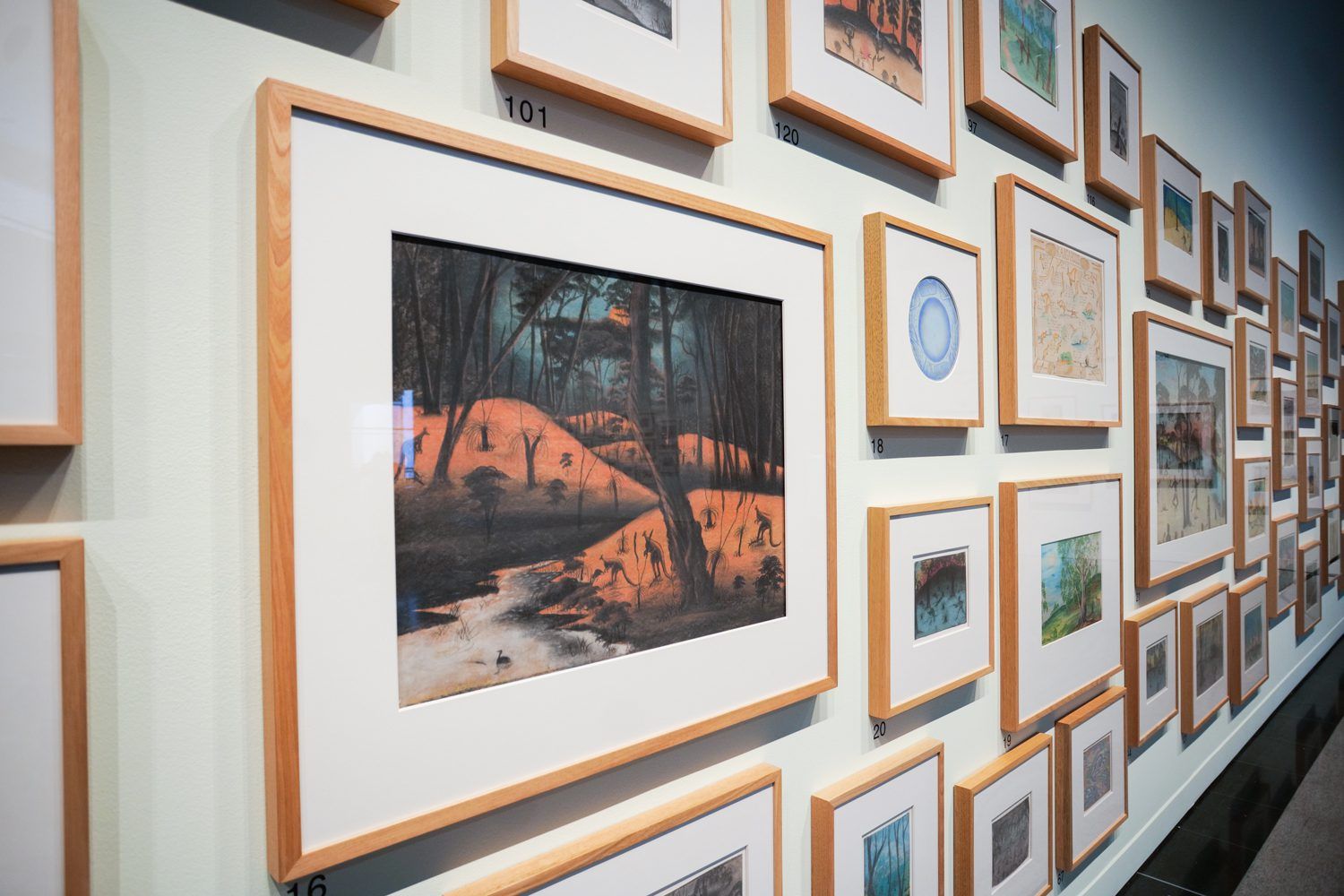
Carrolup artworks on display at John Curtin Gallery.
I hold my community’s aspiration to build a permanent purpose-built ‘home’ for the collection, where the artworks can be preserved and made more accessible for generations to come.
Through improved cultural awareness and greater education, it is hoped we can achieve healing.
The Lotterywest allocation will allow us to carry on with the back end of things – such as our education programs and healing spaces. While it is wonderful to see us moving in the right direction, there is still so much to be done.
We are actually seeing an increase in demand from schools at the moment which is fantastic. They are hearing about the centre through word of mouth and many schools are reaching out.
Multiple generations were impacted by colonial settlement in such a detrimental way, and while you can’t fix that overnight, by working in partnership with one another we can bring about positive change.
Your Mum Alma brought about positive change. As the first Aboriginal woman in WA to achieve a degree in the Fine Arts, you must have been incredibly proud of her. Can you tell us a little about your amazing Mum?
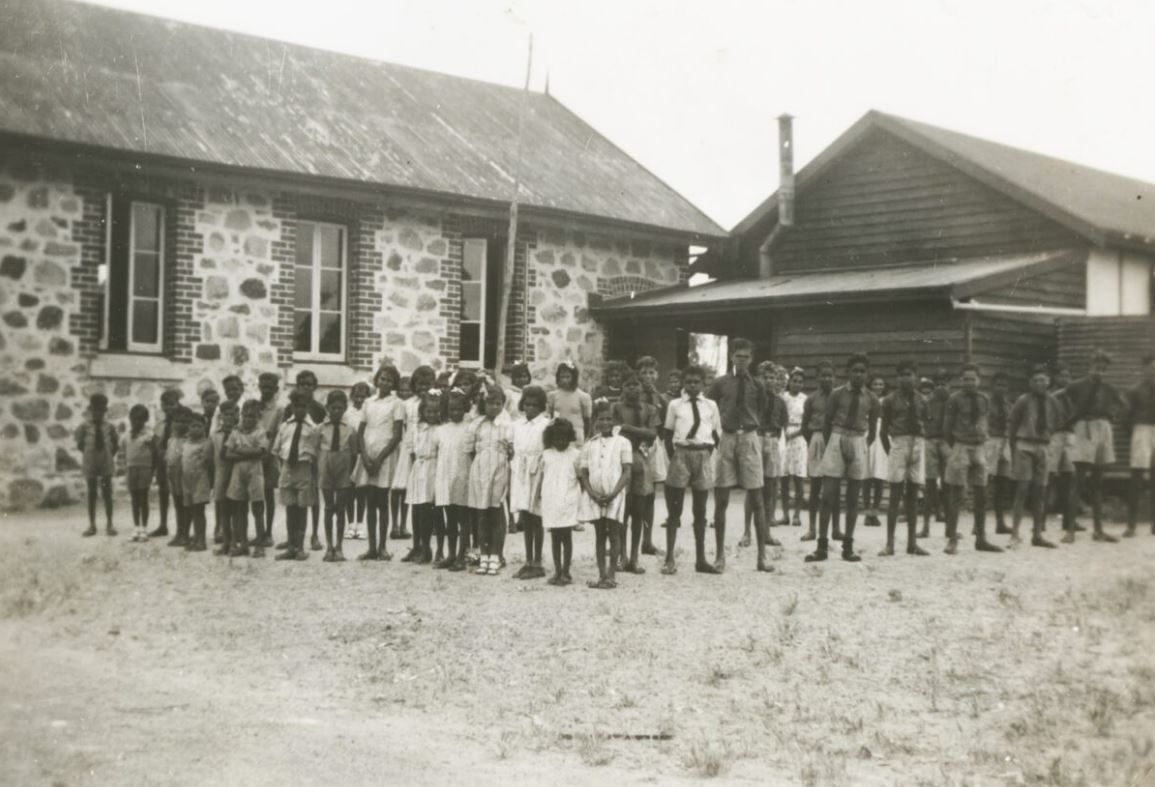
Carrolup Native Settlement in Katanning.
Mum was born in Mount Barker in the South West in 1940, and was forcibly removed from her mother after her father had passed away. She was just four years old.
Despite spending her childhood incarcerated, Mum had a great sense of humour. We were always sharing a laugh, mostly at ourselves.
I find humour interesting, because it definitely has a place in the healing space. If you’ve been through a profound experience humour can make all the difference. After a good laugh you just feel better afterwards. Sure the problem might still be there, but it no longer feels like it’s attacking you.
Mum was also physically and mentally resilient. To be incarcerated from the age of 4-18 couldn’t have been easy but she made peace with her experience later in life and set a wonderful example for us kids by pursuing an education and giving us a stable home.
Mum passed away a year ago on my birthday.
It was also a year to the date that I took Mum back to Country to live out her final days.
Is it safe to assume she was your greatest influence in your life?
I would have to say both my parents were my greatest influence. While Mum had this wonderful natural talent for art, which has consequently rubbed off on me, it was actually my father John, who is from Ireland, who got her to the point where she was ready to take that next step and pursue a degree in art.
When Mum enrolled at WAIT (Western Australian Institute of Art) to undertake a one-year bridging course, Dad changed his work hours. He’d cook and look after us kids while Mum studied.
I saw Mum come alive during that time. Art brought her so much joy and just knowing someone was there to supporting her gave her that drive and confidence to pursue her dreams.
Our family are part of the change makers due to my mum’s professional art experience, gained from the most humble beginnings at Carrolup.
As a nation, how can we heal from the mistakes from our past? Is there hope?
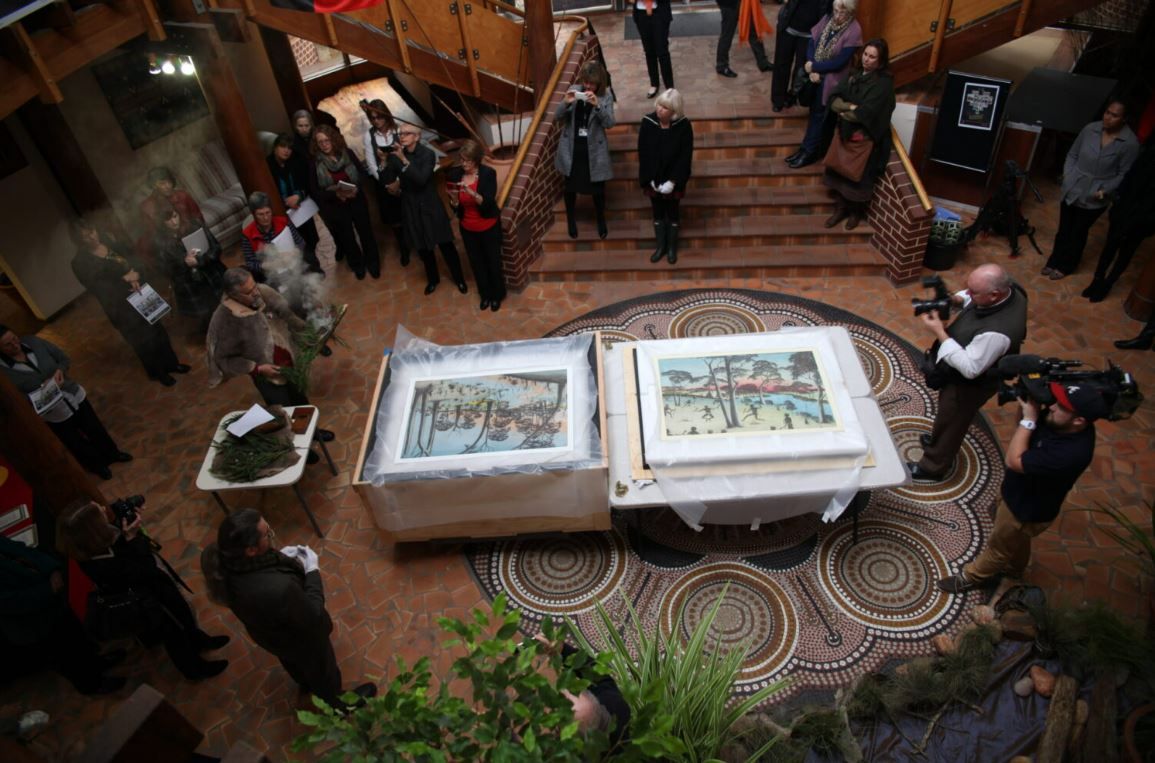
Carrolup artworks being unveiled at Curtin University after nearly 60 years lost overseas.
There is always hope for a better future.
It is a sad indictment on Australia that there are many people who still have no understanding of the impact of colonial settlement, and I take great pride in making that story heard.
There are still huge questions which have never been properly explored, but together we can make Australia the place we all hope it can be.
Where the truth of our history is acknowledged and respected.
These artworks allow us to look through the lens of a child and see how the children of Carrolup built resilience and continued connection to their country through western landscape designs.
Moving forward we need to allow education and healing to occur concurrently and present a model where people can make intergenerational change in a shared space of mutual respect.
It’s great we are starting to greater investment in this area, but there now needs to be a framework which nurtures and supports First Nations people in closing this gap.
To find out more about the Carrolup Centre for Truth-Telling or to book a tour with your school or group please visit https://jcg.curtin.edu.au/carrolup/ or call 9266 4155.
Author | Carmelle Wilkinson
___

